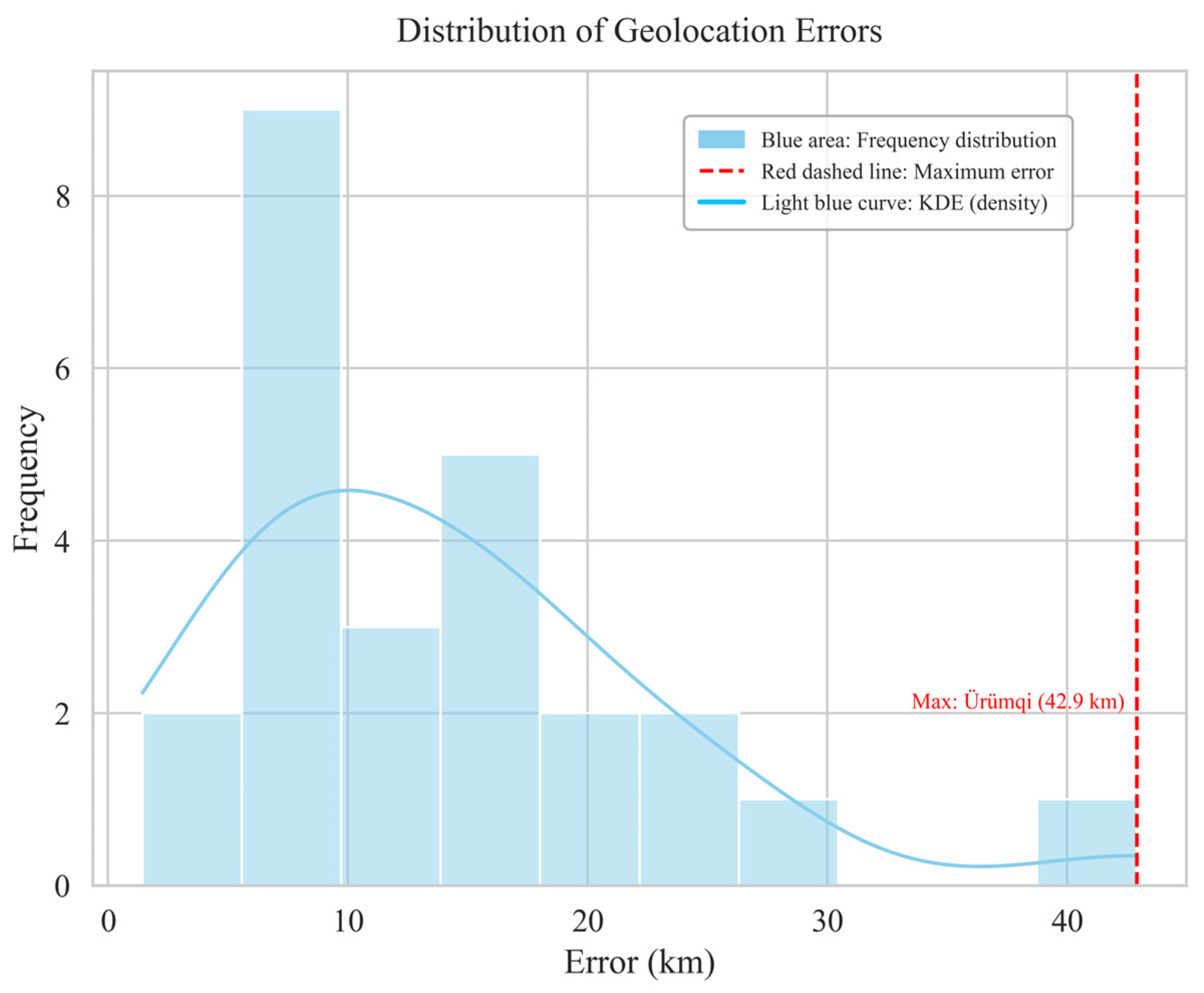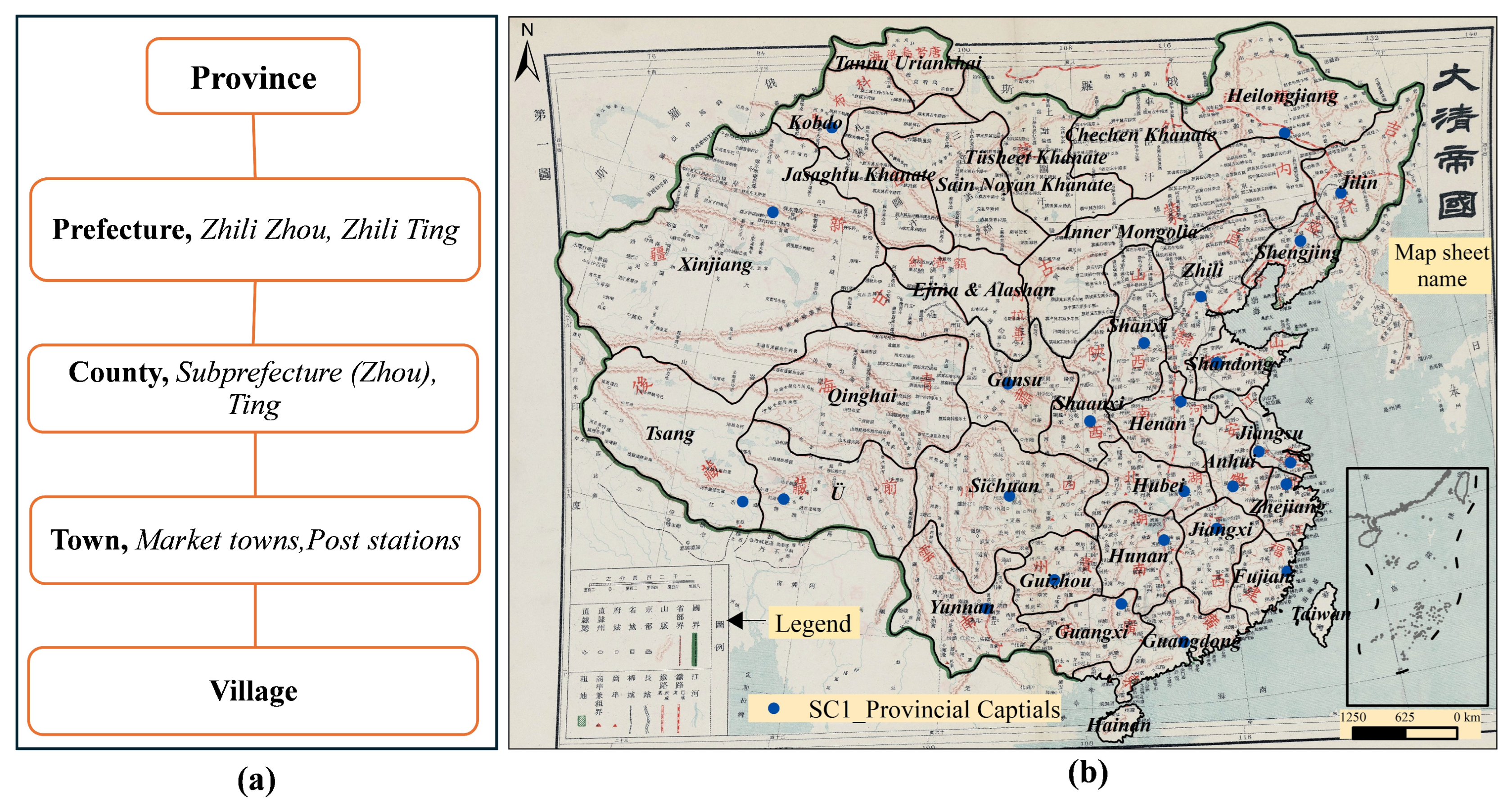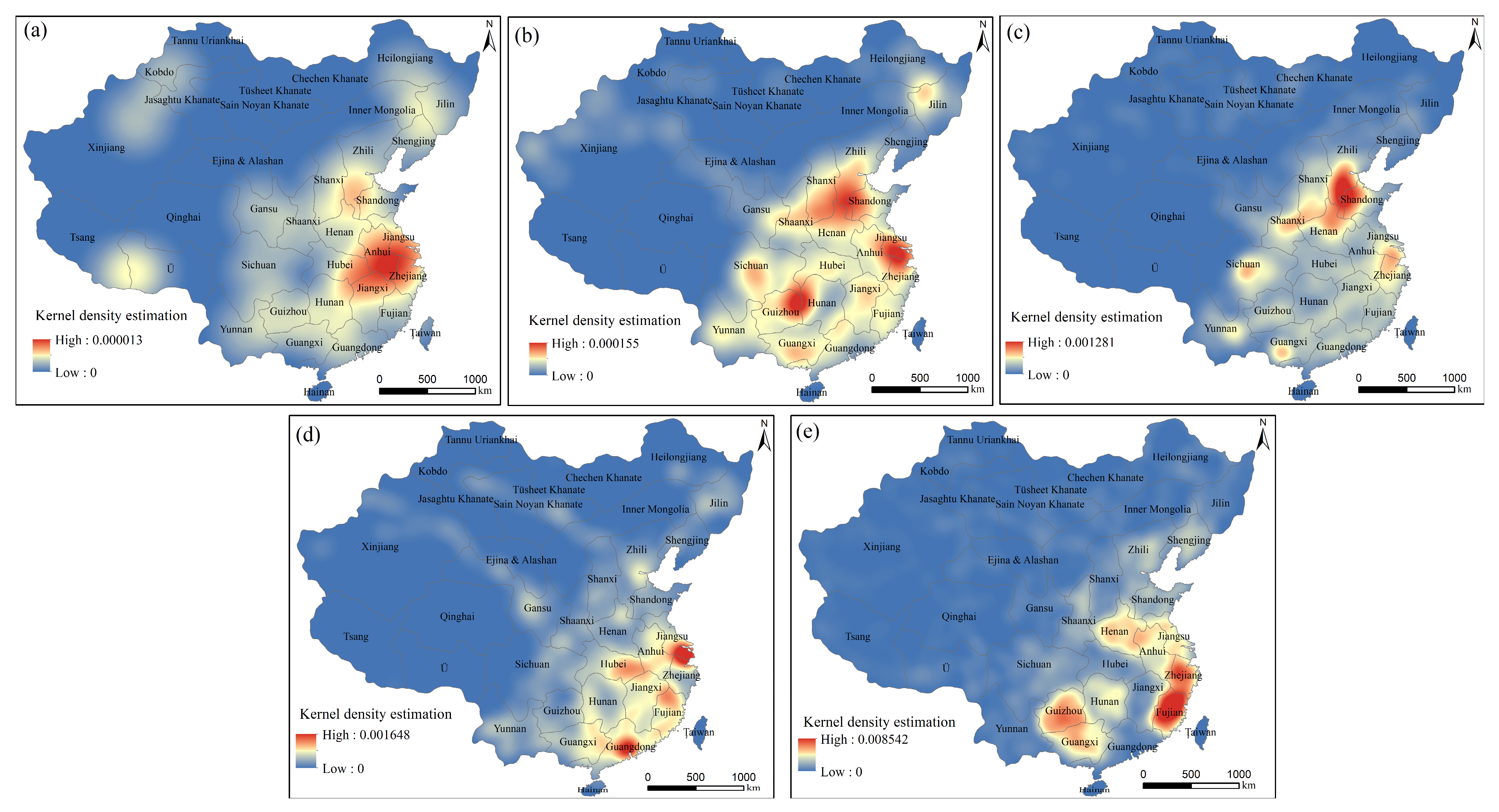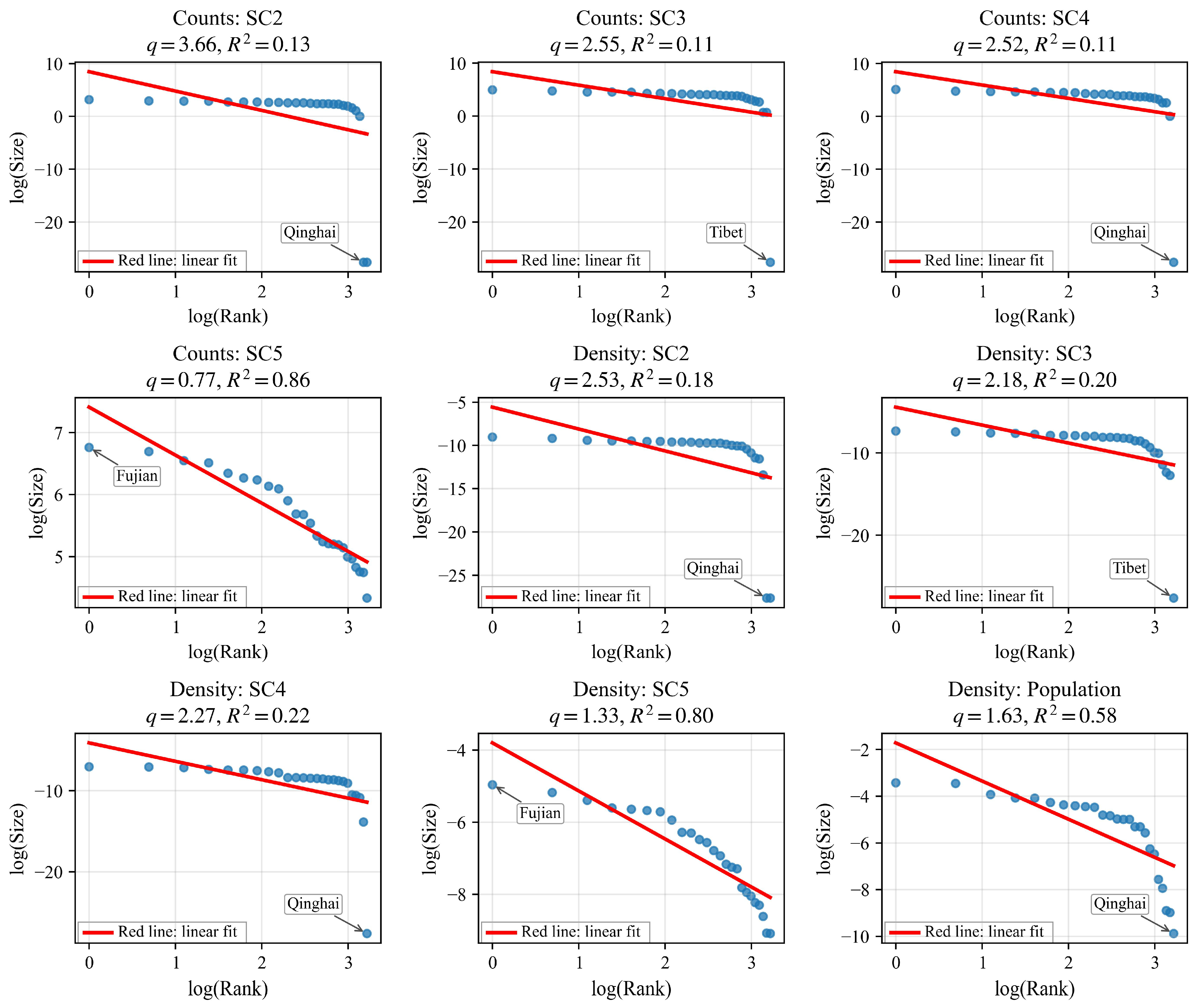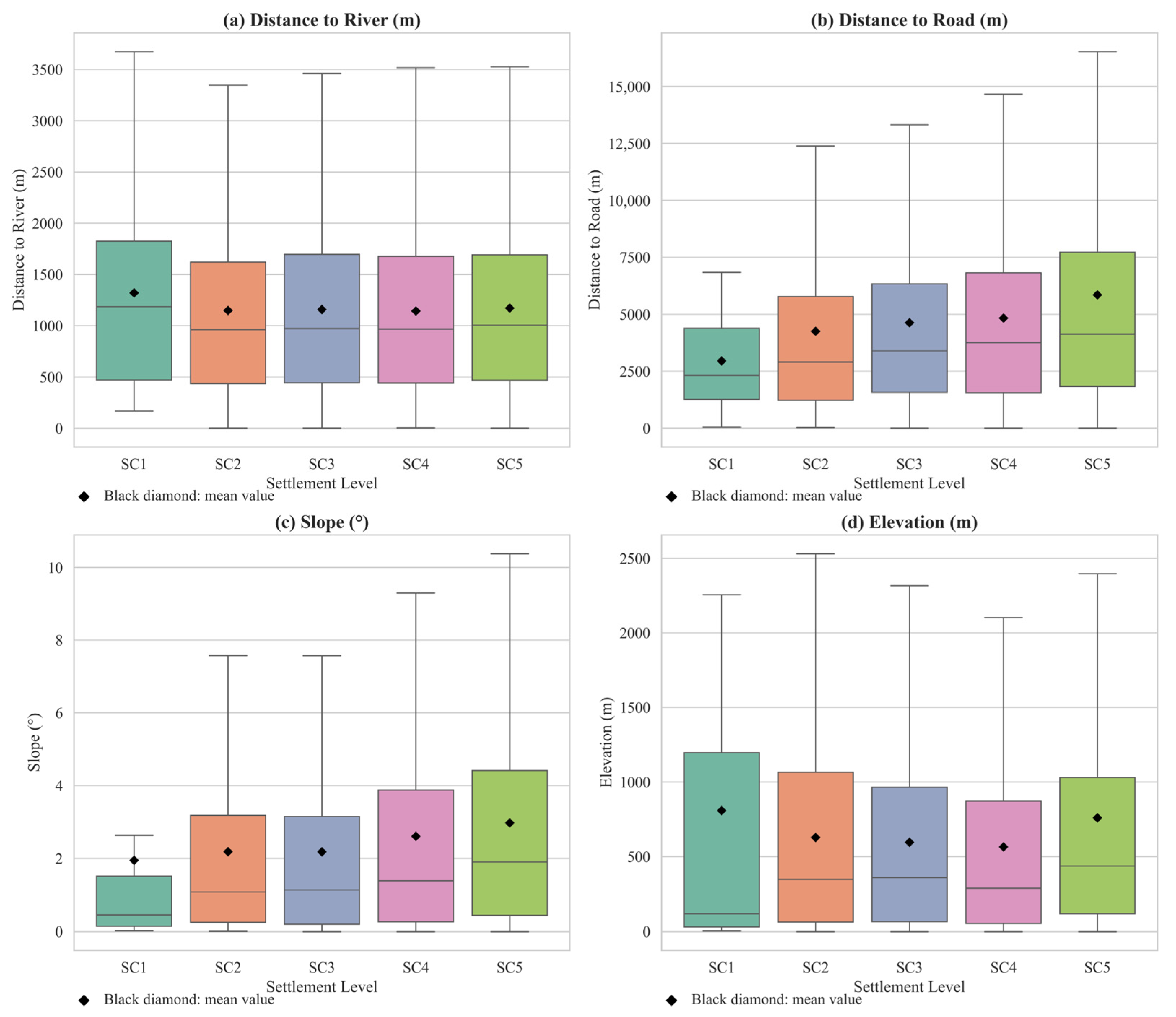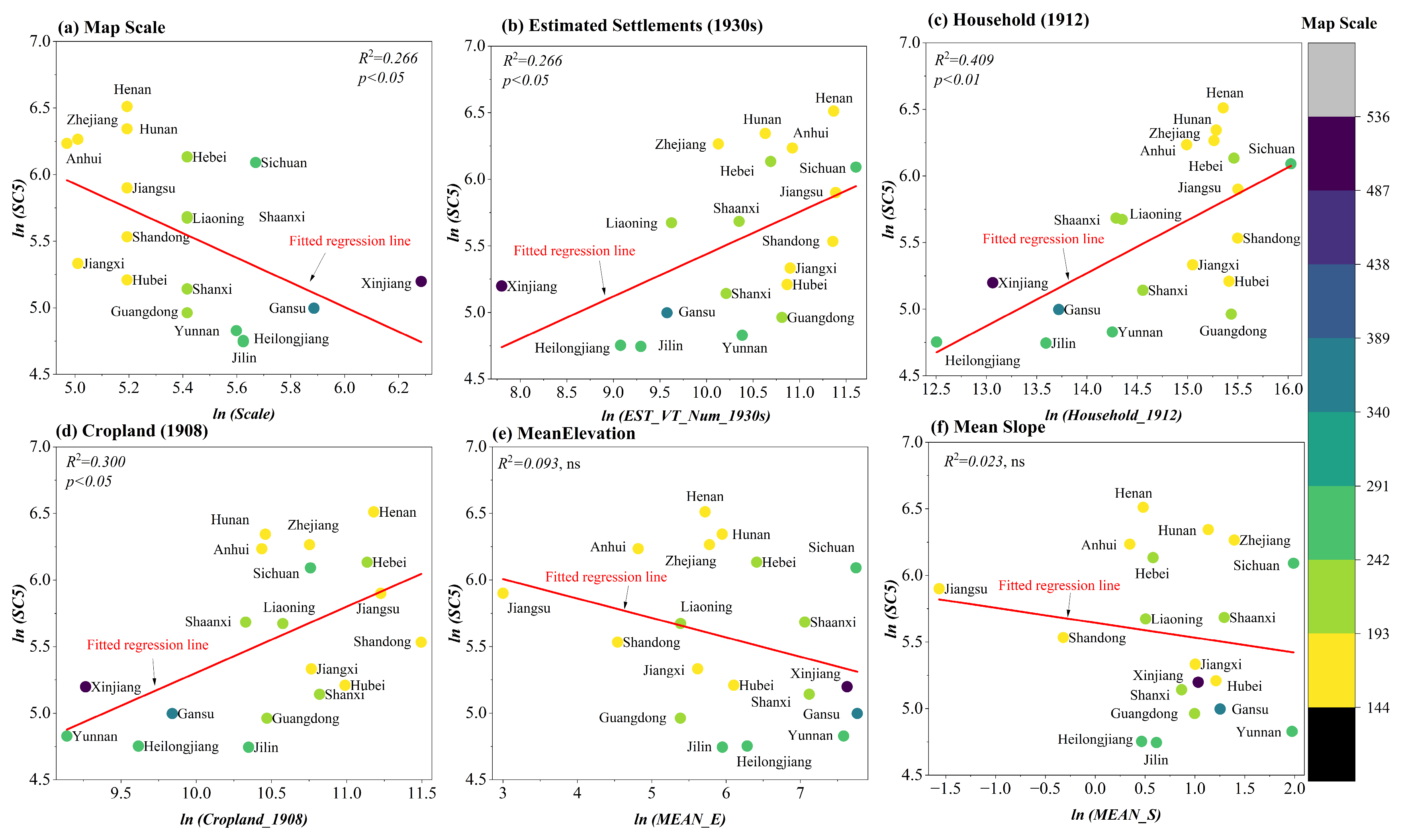1. Introduction
In geography, a settlement refers to a community of people living in a place, and a settlement system is the hierarchical arrangement of such communities by size, population, and services within a region. Meanwhile, settlements and settlement systems have long been the subject of multidisciplinary attention. As the primary spatial carriers of human activities on the Earth’s surface, their patterns and evolutions often embody profound social, cultural, economic, and political significances, while also serving as important indicators of environmental changes [
1,
2,
3]. Long-term studies of settlements can help us understand surface patterns and the underlying interactions between human-social systems, holding significant value in revealing surface processes, social resilience, human-land relationships, spatial economic structures, and cultural patterns [
4].
Existing studies have explored the relationships between settlements and socio-environmental dynamics across various regions and periods. Mortensen (1970s) examined early settlements and population dynamics in Egypt, integrating burial and anthropological data to reveal the profound influences of environmental and social factors on settlement selection and population structure [
5]. Zhang et al. (2005), drawing on archeological and environmental data from the Yangtze River Delta, demonstrated the decisive role of climate and hydrological changes in the development of Neolithic cultures, cultural interruptions, and the rise and fall of civilizations [
6]. Shennan (1993), combining archeological and chronological data, unveiled major transformations in Central European settlements and social structures from 3500 to 1500 BC, including population fluctuations, shifts in gender relations, and the linkages between metallurgical developments and the emergence of chiefdoms [
7]. Easterlin (1976), using the northern United States as a case study, revealed the phased expansion and stagnation of farm populations under land resource constraints, thereby validating the applicability of Malthusian population theory in historical contexts [
8]. Li et al. (2022), taking the mountainous regions of western Hunan as an example, illustrated the spatial characteristics of 18th-century settlement expansion and its socio-cultural roots, driven by policy shifts, population dynamics, and agricultural innovations [
9].
From the perspective of current research, most scholars have focused on the spatiotemporal evolution of settlements and populations, or leveraged them to investigate multidimensional themes—such as social, environmental, economic, and cultural dimensions—in historical periods. However, there remains insufficient attention to the internal structures and interconnectivities of settlement systems themselves [
10,
11,
12]. In fact, as early as the last century, Skinner (1964) demonstrated the integrative role of market networks in traditional agricultural societies through an analysis of China’s rural marketing system, emphasizing that markets function not only as economic mechanisms but also as critical linkages in village-community social structures and broader societal integration [
13]. This perspective offers important methodological insights for examining the spatial structures of historical settlement systems. The diversity of Chinese history, coupled with its abundant documentary records, provides unparalleled conditions for such research. In recent years, with the rapid advancement of interdisciplinary research, studies of settlement evolution have expanded beyond traditional pattern analysis to encompass broader themes such as cultural and environmental adaptation [
14]. The temporal dimension remains a fundamental aspect of geographical inquiry [
15] and is equally crucial in settlement geography and development studies [
16]. Recently, scholars have increasingly emphasized the importance of uncovering or reconstructing settlement patterns using new data sources and methods [
17,
18,
19]. Historical maps, in particular, have emerged as valuable data sources for revealing spatial structures prior to the remote-sensing era (before the 1960s). With the growing integration of digital humanities and artificial intelligence, their potential is being further recognized and explored [
20,
21,
22].
Building on this foundation, the present study employs the preserved Complete Map of the Great Qing Empire (Da Qing Digguo Quantu, 1905) from the late Qing Dynasty to digitally reconstruct the settlement system across mainland China at the turn of the 20th century. Specifically, this study addresses three core questions: (1) What were the spatial distribution characteristics of the settlement system in late Qing China? (2) How were settlement hierarchies shaped by environmental and topographic factors? (3) How can historical maps, such as the Complete Map of the Great Qing Empire, be digitally reconstructed to derive reliable historical settlement data and assess their accuracy?
By addressing these questions, this study not only reconstructs the hierarchical structure of historical settlements on a national scale but also provides a methodological framework for integrating historical cartographic data into quantitative land-system analyses.
This contributes to the broader field of land science by linking spatial reconstruction, environmental adaptation, and socio-political organization within a long-term human–land relationship perspective.
3. Results
3.1. Settlement Distribution Pattern
Based on kernel density estimation (KDE) and local spatial autocorrelation analysis (Local Moran’s
I), settlements of different hierarchical levels in mainland China in the early 20th century exhibited significant spatial distribution differences (
Figure 2a–e).
SC1 (provincial level,
Figure 2a) is concentrated in the Yangtze River Delta, while forming a secondary dense belt in the North China Plain. Henan—Shandong—Zhejiang—Anhui constitute the core agglomeration area. The Mongolian Plateau exhibits a typical low-low agglomeration area. As China’s economic core region since the Song Dynasty, the Yangtze River Delta aggregates the highest hierarchical settlement clusters (
Figure 3a).
SC2 (prefectural level,
Figure 2b) is primarily distributed in the middle and lower reaches of the Yellow River, the Yangtze River Delta, the Sichuan Basin, and the Yunnan-Guizhou Plateau. The provinces and regions exhibiting high-high agglomeration areas form an arc-shaped belt oriented from northeast to southwest, extending from Shaanxi to Yunnan, thereby presenting a typical central corridor pattern (
Figure 3b). This distribution reflects the pivotal role of prefectural seats within the regional administrative network.
SC3 (county-level,
Figure 2c) is primarily concentrated in the North China Plain, Sichuan Basin, and Yangtze River Delta. According to the Local Moran results (
Figure 3c), its agglomeration centers exhibit high overlap with the secondary settlement provinces and regions, forming a northeast-southwest orientation from Zhili to Guizhou. This pattern underscores the hierarchical interconnectivity between prefectures and counties. SC4 (towns and postal stations,
Figure 2d) more prominently reflects economic functions, with distributions centered in the Yangtze River Delta, Pearl River Delta, middle reaches of the Yangtze River basin, and Fujian coastal areas. In China’s southeastern coastal provinces and regions, it displays typical high-high agglomeration, whereas the northwestern regions feature sparse distributions, forming low-low clusters (
Figure 3d).
SC5 (village-level,
Figure 2e) is primarily concentrated in eastern China, particularly along the southeastern coast, southwestern regions, and the provinces and regions in the middle and lower reaches of the Yellow River, demonstrating the characteristic that provinces with larger map scales have more detailed records. According to the Local Moran analysis (
Figure 3e), it still exhibits a high-high zone centered on the Yangtze River Delta, while the northwestern regions form a low-low zone, reflecting spatial disparities in economic development.
3.2. Settlement Clustering Characteristics
To elucidate the spatial agglomeration characteristics of settlements in mainland China at the end of the Qing Dynasty (as reflected in the mapped areas), this study employs the Average Nearest Neighbor Index (NNR) and Moran’s I spatial autocorrelation to analyze settlements of different settlement hierarchies, respectively.
The results indicate that the NNR values for settlements of different hierarchical levels differ significantly (
Table 1). For SC1, the NNR is 1.2054, with a
Z value of 2.0037 and a significance level of
p < 0.05, suggesting that provincial capitals exhibit a slightly dispersed distribution nationwide, primarily due to the limited number of provincial capitals and their adherence to administrative division regulations. In contrast, SC2 (
NNR = 0.7838), SC3 (NNR = 0.7474), SC4 (NNR = 0.5513), and SC5 (NNR = 0.6124) all demonstrate significant clustered distributions, with the NNR values decreasing and the clustering intensity strengthening as the hierarchical level declines. Notably, SC4 and SC5 exhibit
Z values of −34.5313 and −71.1171, respectively, underscoring their highly concentrated distributions and reflecting the strong dependence of grassroots settlements on natural environments and transportation networks. Although the NNR value of SC5 (villages) is slightly higher than that of SC4 (towns), this pattern reflects the broader spatial spacing of agricultural villages rather than a data artifact. As noted by Zhao, historical Chinese settlements exhibited a hierarchical differentiation in which large villages gradually evolved into towns (“ju cun wei zhen,” 巨村为镇, meaning “large villages becoming towns”) [
29]. Villages were constrained by arable land availability and terrain conditions, whereas towns were more concentrated along transportation corridors and trade nodes, leading to a relatively tighter clustering pattern.
The Moran’s
I index further validates this trend (
Table 2). The Moran’s
I values are 0.3818 for SC1, 0.3686 for SC2, 0.5548 for SC3, 0.5900 for SC4, and 0.3637 for SC5, all significant at the 1% level. This indicates that all five hierarchical levels of settlements exhibit overall spatial positive autocorrelation, manifesting as a clustered pattern characterized by “like neighbors like.” Among them, SC3 and SC4 exhibit the highest Moran’s
I values, demonstrating the strongest spatial clustering and suggesting that, within the late Qing settlement system, the spatial organization at the county- and town-levels was the most compact.
In summary, this study draws the following conclusions: the settlement system at the end of the Qing Dynasty exhibits a significant spatial distribution characteristic of “high hierarchical levels being relatively dispersed and low hierarchical levels being highly clustered.” The distributions of provincial and prefectural cities are predominantly influenced by administrative division policies, whereas counties, towns, and villages demonstrate evident spatial self-organization features, which are closely associated with resource accessibility, transportation convenience, and population carrying capacity in the context of an agricultural society.
3.3. Hierarchical Structure and Rank-Size Analysis
In terms of quantity indicators, the slopes for the number of settlements in SC2–SC4 range from
q ≈ 2.52–3.67, while
R2 values are generally low (<0.22) (
Figure 4). The steep slopes indicate a pronounced hierarchical gradient, reflecting strong primacy and concentration of higher-level settlements in a few dominant provinces. However, the low
R2 values reveal weak internal continuity and poor hierarchical coherence, suggesting that the middle- and upper-level settlement systems were fragmented rather than smoothly ordered. In other words, although the hierarchy was steep, the internal structure lacked stability and completeness across provinces.
For SC5, the slope is
q = 0.77 with
R2 = 0.86, showing a good power-law fit (
Figure 4). This indicates a flatter rank-size curve and a more even distribution of numerous small settlements, rather than a strict adherence to Zipf’s law (
q ≈ 1). The pattern suggests that grassroots settlements formed a more continuous and spatially balanced system, highlighting the overall regularity and completeness of the settlement network in densely populated regions.
In terms of density indicators, the q values for SC2–SC4 are approximately 2.27–2.53, with low
R2 values (0.18–0.22) (
Figure 4), indicating substantial spatial density variations among mid- to high-level settlements and strong regional unevenness. In contrast, SC5 (
q = 1.33,
R2 = 0.80) and population density (
q = 1.63,
R2 = 0.58) exhibit better power-law fits (
Figure 4). At the national scale, population distribution adheres to a stronger power-law regularity.
In summary, the Rank-Size analysis reveals that the high-level (SC2–SC3) and SC4 settlement systems are imperfect, characterized by severe hierarchical fractures and regional unevenness. In contrast, the grassroots settlement (SC5) system is relatively complete, with its distribution more closely conforming to Zipf’s law. Provincial population distributions also largely adhere to Zipf’s law, with the corresponding Rank-Size slope for settlement populations being q = 1.14 and R2 = 0.60, approaching the classic Zipf’s law (q ≈ 1). This indicates a tendency toward regularization in the spatial densities of grassroots settlements and population distributions. It further underscores the supportive role of population dynamics in the hierarchization of the settlement system. Overall, these findings elucidate the “duality” of the late Qing Chinese settlement system: imbalance in the upper hierarchies, juxtaposed against a vast and highly regular grassroots structure.
3.4. Influencing Factors of Settlement Hierarchical Distribution
3.4.1. Relationship Between Settlement Hierarchy and Environmental Factors
From the statistical results and box plot comparisons of settlement levels and environmental factors, settlements of different hierarchical levels exhibit certain regular differences in terms of distance to rivers, distance to roads, slope, and elevation (
Figure 5).
1. River Distance The average distances of settlements at various levels to rivers are roughly between 1100 and 1300 m, with no significant differences. The box plots show that the distributions for the five levels are relatively similar, with medians maintained at around 1 km. This indicates that whether settlements are provincial cities, prefectural cities, or grassroots settlements, they all tend to be built along rivers, making rivers a common factor in site selection for settlements of different levels in the early 20th century.
2. Road Distance There are significant differences in road accessibility among different hierarchical levels of settlements. SC1 averages about 3 km from roads, with prefectural and county-level settlements gradually increasing, and SC5 having the highest average distance to roads, reaching 5–6 km. The box plots show that as the level decreases, the mean and median of the distribution overall rise, indicating that higher-level settlements are closer to major transportation routes. This aligns with the functions of provincial and prefectural cities as transportation hubs and administrative centers in the late Qing Dynasty.
3. Slope The lower the settlement level, the greater the slope at its site. The medians for SC1 and SC2 are both below 2°, indicating that high-level settlements are mostly distributed in plains or basins with gentle terrain; meanwhile, for SC5, the median is close to 2°, the 75th percentile is near 4.5°, and some even exceed 20°, reflecting that grassroots settlements are more distributed in hilly and mountainous areas.
4. Elevation Differences in elevation among different levels of settlements are relatively obvious. SC1 has an average elevation of about 800 m, with a wide distribution range; meanwhile, SC3 and SC4 have medians generally below 400 m; SC5, although with an average elevation of about 760 m, has a large distribution span, with some villages located in the Tibetan Plateau region above 6000 m. Overall, high-level settlements are more concentrated in mid-to-low elevation plains and basins, while low-level settlements are more dispersed, including more mountainous samples (
Figure 6).
Overall, high-level settlements (provincial SC1, prefectural SC2) exhibit greater dependence on areas with convenient transportation and gentle terrain for site selection, whereas mid- to low-level settlements (towns SC4, villages SC5) demonstrate stronger terrain adaptability, with broader distribution ranges and particularly higher proportions in high-elevation and mountainous regions (
Figure 6). This underscores the significant coupling relationship between the settlement hierarchy and the natural environment in late Qing China: high-level settlements leverage rivers, roads, and plains to perform administrative and economic core functions, while low-level settlements more prominently reflect the survival and adaptation of human habitations amid complex natural terrains.
3.4.2. Differences and Driving Factors Between Settlement Hierarchy and Environmental Factors
The results of one-way ANOVA indicate that settlements of different hierarchical levels exhibit significant differences in road distance (
F = 18.85,
p < 0.001), slope (
F = 23.87,
p < 0.001), and elevation (
F = 22.29,
p < 0.001), whereas the differences in river distance are not significant (
F = 0.58,
p = 0.676) (
Table 3).
Further Tukey’s HSD post hoc multiple comparisons reveal (
Table 3): (1) In terms of road distance, SC5 differs significantly from SC2–SC4, reflecting that low-level settlements are farther from major transportation trunk lines; (2) In terms of slope, SC5 exhibits significant differences from all other levels, indicating that villages are more frequently distributed in hilly areas with steeper slopes; (3) In terms of elevation, the distribution of SC5 is significantly higher than that of SC3 and SC4, suggesting stronger adaptability of villages to high-elevation terrains; (4) River distance shows no significant differences among levels, indicating that river-dependent siting is a universal feature of settlements, without manifesting hierarchical distinctions.
To further elucidate the influence of environmental factors on settlement hierarchy, this study constructed an ordered logistic regression model, the results of which validate this trend: road distance (
coef = 3.12 × 10
−5,
p < 0.001), slope (
coef = 0.044,
p < 0.001), and elevation (
coef = 0.0001,
p < 0.001) all exert significant positive effects on settlement hierarchy, while river distance remains insignificant (
Appendix C). This indicates that the hierarchical structure of the settlement system in late Qing China is primarily constrained by transportation accessibility and terrain conditions, with high-level settlements concentrated in regions featuring convenient transportation and gentle topography, whereas low-level settlements are more extensively distributed in mountainous and plateau areas.
3.5. Evaluation of Map Scale Effects on Settlement
The varying scales of sub-maps in the Complete Map of the Great Qing Empire may introduce spatial bias in settlement extraction, particularly for low-level settlements (SC5), which are more sensitive to mapping detail. Due to the SC5 in the Qinghai-Tibet Plateau and Mongolian Plateau being mostly drawn along roads, they were not included in the analysis.
To evaluate this effect, regression and visualization analyses were performed using ln(SC5) as the dependent variable and six explanatory factors: ln(Scale), ln(Estimated Settlements_1930s), ln(Household_1912), ln(Cropland_1908), ln(Mean Elevation), and ln(Mean Slope).
Scatterplots revealed that Fujian, Guizhou, and Guangxi were distinct outliers, with abnormally high SC5 values relative to their scales (
Figure 7). Across all provinces, ln(Scale) and ln(SC5) show a significant negative relationship (
R2 = 0.36,
p < 0.01), indicating that smaller-scale maps tend to contain fewer recorded villages. Household also shows a positive correlation (
R2 = 0.20,
p < 0.05), while other factors were not significant.
When the three outlier provinces were excluded, the correlations strengthened markedly (
Figure 8): Scale–SC5 (
R2 = 0.27,
p < 0.05), Estimated Settlements 1930s–SC5 (
R2 = 0.27,
p < 0.05), Household–SC5 (
R2 = 0.41,
p < 0.01), and Cropland–SC5 (
R2 = 0.30,
p < 0.05). This confirms that extreme scale deviations concentrated in a few provinces may distort national patterns.
Multiple regression analysis (
Table 4) using ln(Scale), ln(Household_1912), ln(Cropland_1908), ln(Mean Elevation), and ln(Range Slope) further validates this pattern. For the full sample (
N = 22), the model shows
R2 = 0.52 (Adj.
R2 = 0.37,
F = 3.49,
p = 0.025), with a negative but statistically weak coefficient for Scale (–0.81,
p = 0.16). After excluding the three provinces (
Table 5) (
N = 19),
R2 = 0.43 (Adj.
R2 = 0.21,
p = 0.15), and the Scale coefficient diminishes (–0.34,
p = 0.59). Thus, map scale effects are primarily localized rather than systemic, and removing the outliers does not substantially alter the national model (Δ
R2 < 0.1).
Overall, these results suggest that map scale correlates with spatial variation in SC5 but acts more as a derivative indicator linked to topographic complexity and socioeconomic conditions rather than an independent driver. Consequently, while scale bias exists, it does not significantly distort the national-level conclusions on settlement hierarchies. The detailed regression coefficients and statistics are provided in
Table 4 and
Table 5 and
Appendix D. For clarity,
Table 4 and
Table 5 summarize the results for the full and reduced samples, while additional models examining the determinants of map scale and household distribution are reported in the
Appendix D.
4. Discussion
This section discusses how the empirical results address the study’s main questions regarding the spatial distribution, hierarchical structure, and environmental determinants of settlements in late Qing China.
4.1. Causes of Formation of Settlement Distribution Patterns
This study indicates that by the end of the Qing Dynasty (late 19th to early 20th century), the Chinese settlement system had evolved to a critical period of social transformation marked by increasingly close connections between China and the world [
30]. The spatial pattern of the national settlement system exhibits the following characteristics: high-level settlements are distributed relatively dispersed, whereas mid-to low-level settlements demonstrate high clustering. This disparity primarily stems from three aspects:
First, the establishment of high-level settlements such as provinces and prefectures adheres to the distribution pattern of national administrative divisions, placing greater emphasis on spatial equilibrium in political jurisdiction rather than optimal selections based on economic and natural conditions. This aligns closely with the insights from studies on Chinese historical political geography. Existing research indicates that “
mountains and rivers convenient” (shanchuan xingsheng, 山川形胜) and “
interlocking teeth” (quanyan jiaocuo, 犬牙交错) constituted the two major principles of administrative divisions during historical periods in China. The former delineates administrative divisions based on natural geographical conditions, yet geomorphic areas such as basins are prone to fostering local decentralization that opposes central authority [
31]. Consequently, “artificial administrative divisions” (such as the multiple provinces of the Yuan Dynasty) that span multiple natural geomorphic areas and are dominated by central power emerged as necessary choices [
31]. Therefore, the settlement system in China at the turn of the 20th century can also be interpreted from the perspective of spatial power.
Second, low-level settlements are more dependent on natural environments and transportation conditions, particularly the constraining effects of road accessibility, terrain slope, and elevation, which give rise to evident self-organizing clustering phenomena in social behaviors and economic activities. This aligns with G. William Skinner’s interpretation of the traditional Chinese settlement system, integrating Christaller’s Central Place Theory [
13,
32]. Furthermore, transportation networks represent a crucial aspect of China’s national spatial organizational capacity during historical periods (including the transmission of information and the transfer of materials [
33]), while the importance of rivers has relatively declined. This also explains why river distance did not exhibit significance in the statistical tests of this study.
4.2. Explanation of Settlement Hierarchical Differences
Through the systematic digitization of the Complete Map of the Great Qing Empire, this study reveals, at the national scale, the coexistence of hierarchical fractures and underlying regularities within the settlement system. On one hand, Rank-Size analysis indicates that the mid- to high-level settlement system is imperfect, lacking an ideal power-law distribution and exhibiting a pronounced “fractured” pattern, which is largely attributable to the spatial operations of political power. On the other hand, low-level settlements and population distributions more closely conform to Zipf’s law, reflecting the universality and orderliness of the underlying network. These findings suggest that during the social transformation process in modern China, the administratively dominated upper hierarchy displayed imbalance and vulnerability, whereas the grassroots settlement network played a more enduring role in sustaining social operations and population carrying capacity.
Christaller proposed the Central Place Theory in the early twentieth century (1933) [
32], which emphasizes that settlements of different hierarchical levels form a spatially ordered system based on service capacity and market range. The case of early-twentieth-century China illustrates a comparable pattern: higher-order settlements such as provincial and prefectural centers functioned as major central places, offering diversified services over broader areas; meanwhile, lower-order settlements, such as villages, served as minor central places with limited functions, smaller service radii, and denser distributions. The location and spacing of these centers were essentially determined by their threshold and range.
In late Qing China, higher-level settlements (SC1–SC3) were concentrated at administrative and transportation nodes, performing regional coordination and market functions analogous to Christaller’s higher-order centers. In contrast, lower-level settlements (SC4–SC5) exhibited a more uniform and spatially continuous pattern, providing localized services within agrarian landscapes.
However, the observed hierarchy also departs from the idealized hexagonal regularity envisioned by Christaller. The steep rank-size slopes (high q values) and fragmented mid-level structures reveal the influence of administrative boundaries, topographic constraints, and agrarian production systems, which shaped a state-regulated rather than purely market-driven central-place network. This indicates that the Qing settlement hierarchy embodied both functional centrality and territorial governance, adapting central-place logic to a national social-economic and political context.
Furthermore, the various cartographic elements, including the scale, also embody hierarchy. Text, image, and the construction of regional knowledge are essential components of Humanistic Geography. As Buttime argues, humanistic geography concerns not only how people interpret their everyday “lifeworlds,” but also how academic and cartographic representations project particular “mindscapes” [
34]. In this sense, the variations in map scale observed in this study also reflect deeper socio-economic and geographical factors, particularly their dependence on provincial area and administrative delineation. The provincial maps of the
Complete Map of the Great Qing Empire thus function as visual confirmations of the political spatialization of power, where the delineation of provinces and counties represents a human-constructed geography deeply embedded in administrative and cultural logics.
4.3. Limitations and Prospects
It should be noted that this study still has several limitations. First, the Complete Map of the Great Qing Empire features varying scales across its sub-maps, with some regions (such as the Tibetan Plateau and northwestern frontiers) exhibiting missing place names or uncertain boundaries, potentially leading to uneven settlement data. Second, the research primarily relies on natural environmental and transportation factors, without incorporating the socio-economic, social, and institutional factors prevalent at the time. Future studies could introduce richer multi-source historical geographic data (such as population censuses and railway transportation records) for comprehensive analysis, thereby further deepening the interpretation of the causal mechanisms underlying settlement patterns. Additionally, systematic application of spatial georeferencing and error correction methods in future research would enhance data precision and the reliability of results.
Although the map-scale heterogeneity among sub-maps inevitably introduces minor regional bias—particularly in southwestern provinces—our regression analysis (
Section 3.5) shows that such bias has limited statistical significance after excluding extreme cases. Therefore, while scale differences should be acknowledged as a data limitation, they do not systematically alter the main spatial or hierarchical conclusions of this study.
5. Conclusions
Overall, these findings directly address the research questions outlined in the Introduction and extend both theoretical and empirical understandings of settlement hierarchy and human–land interaction in historical China.
Utilizing digitized data from the Complete Map of the Great Qing Empire (1905), this study systematically reconstructs and analyzes the spatial structure and formative mechanisms of the settlement system in mainland China at the end of the Qing Dynasty. The main conclusions are as follows:
1. The late Qing settlement system displays a typical dual structure—relatively dispersed high-level settlements and highly clustered low-level ones—reflecting the combined effects of administrative division and environmental–transportation conditions.
2. Rank–Size analysis reveals pronounced hierarchical steepness and regional unevenness among mid- to high-level settlements, whereas the grassroots system exhibits a more even and continuous pattern approximating Zipf’s law.
3. Statistical analyses identify transportation accessibility, slope, and elevation as major determinants of settlement hierarchy, while river proximity plays a minor role. These results suggest that the organization of settlements in late Qing China was primarily shaped by transportation connectivity and terrain adaptability.
In summary, the late Qing settlement system embodied a clear duality: the administratively dominated upper hierarchy was fragmented and vulnerable, whereas the self-organizing grassroots network was extensive and resilient.
By bridging spatial–statistical analysis with historical cartography, this study not only reconstructs the macro-scale structure of China’s pre-modern settlements but also extends central-place and humanistic perspectives to an imperial agrarian context. It thus contributes to the broader field of land science by demonstrating how digitized historical maps can serve as quantitative evidence for exploring long-term human–land systems and the spatial evolution of socio-environmental organization.
